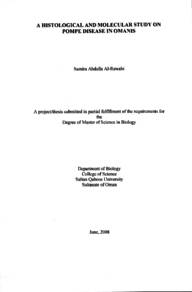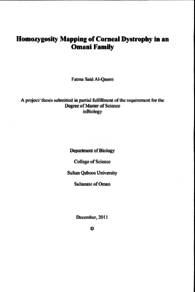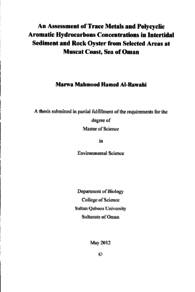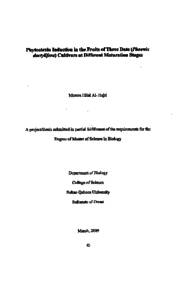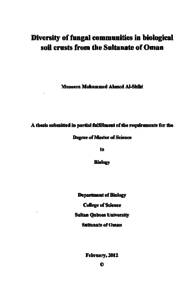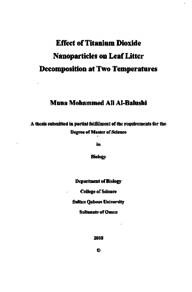Document
.Removal of hexavalent chromium by microbial mats under anaerobic conditions and associated shifts in their bacterial community composition
Publisher
Sultan Qaboos University
Gregorian
2019
Language
English
Subject
English abstract
The pollution with Cr (VI) in the environment is widespread mainly due to its uses in various industrial applications such as chrome plating, stainless steel, preparation of alloys and industrial water cooling. Although several studies have been conducted
previously to evaluate the bioremediation of Cr(VI)-contaminated areas, very little is known regarding the role of microbial mats in this approach. The current study is based on the microbial mats naturally developed at three locations within an abandoned
chromite mining site in Nakhal, Oman. The objectives of the study included investigating the removal of 1, 5, 15, 20 and 50 mg L-1 of Cr(VI) by microbial mats A, B and C under anaerobic conditions using spectrophotometry and inductively-coupled
plasma optical emission spectroscopy (ICP-OES) and evaluating the associated shifts in the mat bacterial communities at the end of degradation using Illumina MiSeq. The degradation of different concentrations of Cr(VI) depended on the microbial
composition of the mat and the Cr(VI) concentration itself. Mat A samples continued to show a rapid reduction in the Cr(VI) concentration until zero values were detected after 23 days. However, a complete removal of Cr(VI) by mats B and C were detected only after 29 days. Further investigation revealed that the same mat A required different incubation periods when Cr(VI) concentration was increased in the site water. The NMDS analysis of the MiSeq data obtained showed that microbial mats underwent distinct community shifts depending mainly on the Cr(VI) concentration and the inherent bacterial community of the mat. Mat A samples showed a clear shift in the bacterial community structure in favour of Clostridia at 1 mg L-1 Cr(VI) while when exposed to higher concentrations of Cr(VI), the bacterial community structure was altered in favour of Gammaproteobacteria, Bacilli and Alphaproteobacteria. Thus, microbial mats can serve as effective bioremediation agents for Cr(VI)-contaminated areas in the natural environment. Future research should focus on the isolation of
potential Cr(VI)-degrading microbial strains that can perform decontamination even under anaerobic conditions. Future research should focus on the isolation of potential Cr(VI)-degrading microbial strains that can perform decontamination even under anaerobic conditions.
Arabic abstract
ينتشر التلوت بالكروم السداسی( C ( VI في البيئة بشكل أساسي بسبب استخدامه في التطبيقات الصناعية المختلفة مثل الطلاء بالكروم والفولاذ المقاوم للصدأ وإعداد النسيان وتبريد المياه الصناعي و على الرغم من أن العديد من الدراسات قد أجريت سابقا لتقييم المعالجة الحيوية للمناطق الملوئة بالكروم السداسي ( Ci( VI عرفت إلا أنه لا يوجد سوى القليل جدا فيما يتعلق بنور التجمعات البكتيرية في هذا النهج وتعتمد الدراسة الحالية على التجمعات البكتيرية التي تم تطويرها بشكل طبيعي في تفتة مواقع داخل موقع التعدين الملوت بالكروم في نخل في سلطنة عمان ، حيث شملت أهداف الدراسة الحالية التحقيق بواسطة التجمعات البكتيرية C و B و A) في إزالة خمس تركيزات من الكروم السداسي ( Ci( VI( 50 و 20 و 15 و 5 و 1 ملغ ليتر) في ظل ظروف لا هوائية باستخدام القياس الطيفي وجهاز ( ICP- OES ) وتقييم التحولات المرتبطة في المجتمعات البكتيرية في نهاية التعرض للتراكيز المختلفة للكروم السداسي باستخدام تقنية ( Illumina MiSeq) حيث إن التفكك لمختلف التركيزات للكروم السداسي ( Cr( VI في التجمع البكتيري نشه(A) يعتمد على المكونات البكتيرية للتجمعات ويعتمد أيضا على التركيز للكروم السداسي. حيث أظهر التجمع البكتيري (A) انخفاض سريع في تركيز الكروم السداسي ( Ci ( VI حتى تم اكتشاف قيم صقرية بعد 23 يوم. إلا أنه تم اكتشاف إزالة كاملة للكروم السداسي ( Cr ( VI بواسطة التجمع البكتيري C و r B فقط بعد 29 يوم ومع مزيد من البحث تم التوصل إلى أن نفس التجمع البكتيري تتطلب قرات حضانة مختلفة عندما تم زيادة تركيز الكروم السداسي (1) Cr، وأظهر تحليل NMDS ليباتات العينات إل MiSeg أن التجمعات البكتيرية خضعت للتحولات المجتمعية المتميزة بشكل أساسي و مجتمع البكتيريا الموجود أصلا في التجمع البكتيري. كما أظهرت بيانات (Illumina MiSeq عينات التجمع البكتيري A تحولا واضح في بنية المجتمع اعتماد الكروم السداسی Cr VI) حيث أنه عند تعريضه لتركيز 1 ملغ /ليتر أظهرت النتائج بنية المجتمع لصالح Clostridia ، بينما أثناء تعرضها لتركيزات أعلى من الكروم السداسي ( Cr
( VI تم تحول المجتمع البكتيري لصالح Alphaproteobacteria و Bacilli و Gammaproteobacteria ولقد توصلت الدراسة الحالية أنه يمكن أن تكون المجتمعات البكتيرية بمثابة عوامل فعالة للعلاج الأحيائي للمناطق الملوئة بالكروم السداسي في البيئة الطبيعية . كما أنه يتوجب أن تركز الأبحات المستقبلية على عزل السلالات الميكروبية المحتملة التي تساخنا في التخلص من التلوث بالكروم السداسي حتى في ظل الظروف اللاهوائية.
( VI تم تحول المجتمع البكتيري لصالح Alphaproteobacteria و Bacilli و Gammaproteobacteria ولقد توصلت الدراسة الحالية أنه يمكن أن تكون المجتمعات البكتيرية بمثابة عوامل فعالة للعلاج الأحيائي للمناطق الملوئة بالكروم السداسي في البيئة الطبيعية . كما أنه يتوجب أن تركز الأبحات المستقبلية على عزل السلالات الميكروبية المحتملة التي تساخنا في التخلص من التلوث بالكروم السداسي حتى في ظل الظروف اللاهوائية.
Member of
Resource URL
Same Subject
